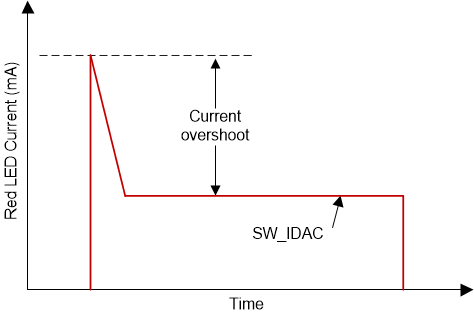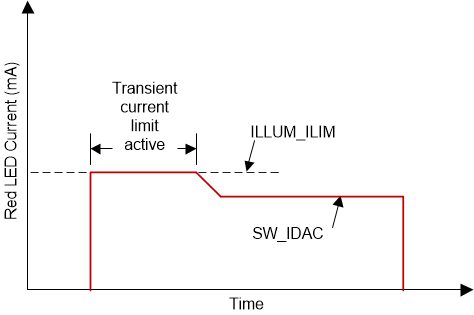DLPS132 May 2018 DLPA4000
PRODUCTION DATA.
- 1 Features
- 2 Applications
- 3 Description
- 4 Revision History
- 5 Pin Configuration and Functions
- 6 Specifications
-
7 Detailed Description
- 7.1 Overview
- 7.2 Functional Block Description
- 7.3
Feature Description
- 7.3.1 Supply and Monitoring
- 7.3.2 Illumination
- 7.3.3 External Power MOSFET Selection
- 7.3.4 DMD Supplies
- 7.3.5 Buck Converters
- 7.3.6 Auxiliary LDOs
- 7.3.7 Measurement System
- 7.4 Device Functional Modes
- 7.5 Programming
- 7.6 Register Maps
- 8 Application and Implementation
- 9 Power Supply Recommendations
- 10Layout
- 11Device and Documentation Support
- 12Mechanical, Packaging, and Orderable Information
Package Options
Mechanical Data (Package|Pins)
- PFD|100
Thermal pad, mechanical data (Package|Pins)
- PFD|100
Orderable Information
7.3.2.5.3 Transient Current Limit
Typically the forward voltages of the green diodes and the blue diodes are equivalent to each other (between 3 V and 5 V). However the forward voltage of the red diode is significantly lower (2 V to 4 V). This difference can lead to a current spike in the RED diode when the strobe controller switches from green or blue to red. The spike occurs because the LED voltage (VLED) is initially higher than required to drive the red diode. DLPA4000 limits the transient current for each switch in the LEDs during the transition. Use register 0x02 (ILLUM_ILIM) to control the transient current limit. A typical application requires this limit for only for the RED diode. Set the value for ILLUM_ILIM to at least 20% higher than the DC regulation current. Use the three bits of register 0x02 (ILLUM_SW_ILIM_EN) to select which switch controls the transient current limiting feature. Figure 10 and Figure 11 show the effect of the transient current limit on the LED current.
For high-side pump applications, where there are two series stacked LEDs for green, sequence precautions are needed to avoid damaging the LEDS. Always transition from high-side pump green to blue, avoid following the green with red.
 Figure 10. LED Current Without Transient Current Limit
Figure 10. LED Current Without Transient Current Limit
 Figure 11. LED Current With Transient Current Limit
Figure 11. LED Current With Transient Current Limit